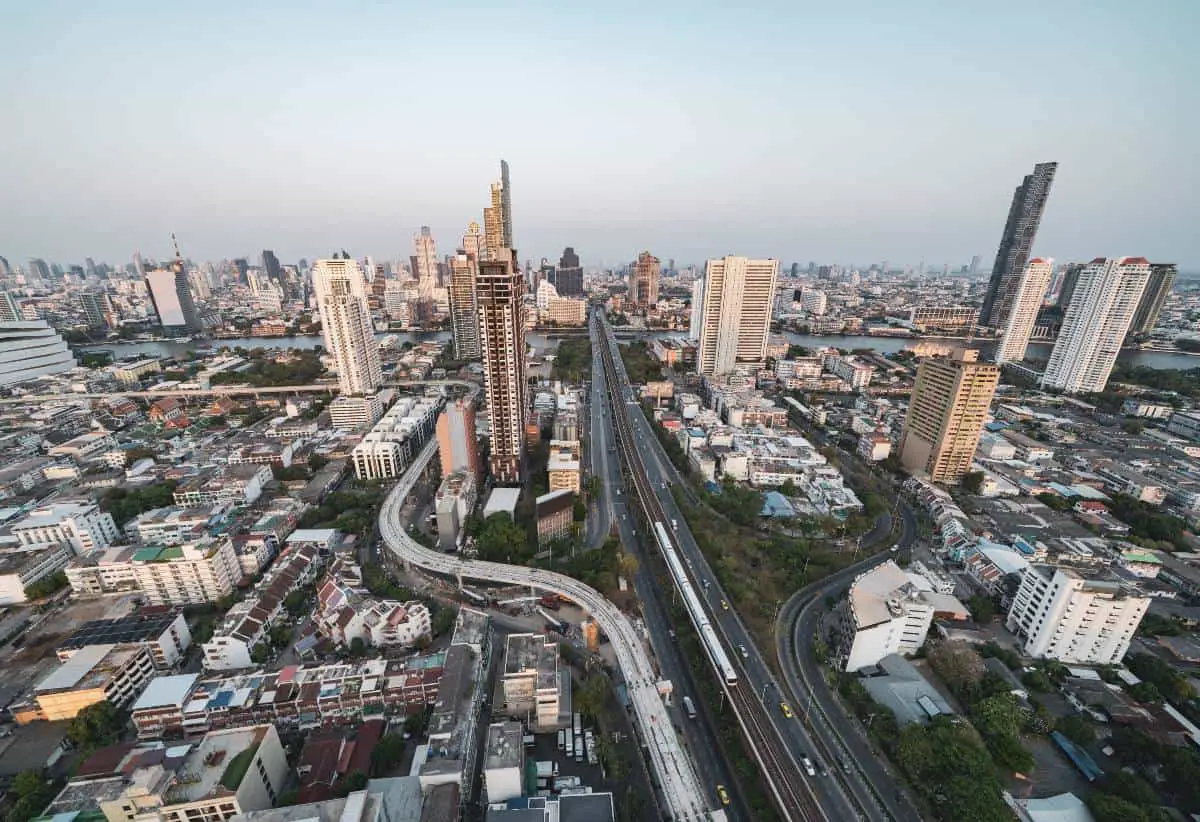Must-Know Challenges of Driving in Thailand [Expats]
For many foreigners, the idea of driving in Thailand can seem chaotic and dangerous. With unconventional traffic patterns, confusing regulations, language barriers, and more, it’s easy to feel overwhelmed. But with some preparation and insight into local conditions, your experience behind the wheel in Thailand can be safe and enjoyable.
Key Takeaways
- Understanding Thai road laws and dealing with local authorities requires careful attention
- Navigating congested traffic in Bangkok needs effective strategies
- Road safety is a significant concern with leading causes of accidents being speeding, drunk driving, and hazards like motorbikes
Understanding Thai Road Laws and Regulations
The first obstacle for foreigners is decoding Thai road rules and regulations. While the fundamentals are similar, many specific traffic laws differ significantly from Western countries.
Speed limits fluctuate frequently, with the maximum highway speed being 120 km/hr but limits drop sharply within municipalities. Urban areas rarely post speeds, so you’ll need to keep pace with traffic flow.
Lane Regulations
- Passing lanes on highways work opposite than in the West
- Tailgating is common, so keep alert to sudden stops
- Motorbikes use all parts of the road, so continually check blind spots
Adhering to regulations is critical, as traffic police strictly enforce laws through random police checkpoints on roads and highways. Fines for violations like speeding often start at 500 THB.
While signs use universal symbols, being able to interpret specific road signs helps avoid confusion. For instance, many one-way streets in cities only forbid cars but allow bikes both ways.
Navigating Traffic in Bangkok
Nowhere exemplifies the chaos of Thai roads like the capital Bangkok. With nearly 10 million registered vehicles, the city’s cramped streets hum with a dizzying mix of cars, buses, motorbikes, and vendors. Rush hour and rainy weekends bring legendary gridlock.
Despite the madness, several tactics can make drives easier:
- Google Maps works well but doesn’t account for route quality or hazards
- Apps like Maps.me allow offline navigation using updated maps
- Avoid small sois (side streets) if possible, as they are narrow and lack signs
- Find parallel routes to main thoroughfares to bypass traffic jams
Most importantly, adjust your expectations, relax, and go with the ebb and flow. Don’t rush or let impatience put you or others at risk. As locals say, “Mai pen rai” (no worries)!
Dealing with Thai Police and Authorities
As a foreigner, interacting with police after an accident or violation can be intimidating. But following some basic guidelines can help:
- Stay calm and be polite, even if at fault
- If possible, contact your embassy
- Fines are steep, but can sometimes be negotiated on the spot
- Dash cams help dispute false claims if trouble arises
- Minor collisions often end in amicable cash settlements on-site to avoid paperwork
Remember, English proficiency among officials can vary greatly, so remain patient. Also, beware of potential scams from impersonators posing as police.

Safety Tips for Road Users
While accident rates have improved recently, road hazards still abound in Thailand for both drivers and pedestrians:
Main Causes of Accidents
- Speeding and drunk driving
- Reckless overtaking on highways
- Visibility issues on narrow, unlit rural roads
- Sudden swerving into traffic by untrained motorbike operators
Minimizing Risks
Stay vigilant for erratic maneuvers, use headlights responsibly, allow safe following distance between vehicles, and avoid drinking and driving which remains a prevailing issue.
Specialized driver’s education for foreigners is also available in major municipalities to promote safety for all.
Understanding Speeding and Fatality Rates
Thailand’s speed limits balance safe velocities while supporting the nation’s transit needs. However, despite bans on lead-footing implemented in speed traps and checkpoints, violations remain widespread with over 60% of accidents involving excess speed. These behaviors contribute to an alarming traffic fatality rate that is double the global average and the highest among comparable countries.
Thankfully authorities are targeting improvement through various channels:
- Public awareness campaigns
- Increased traffic cameras/radar enforcement
- Harsher punishments for offenses
- Improving transparency into violation costs and consequences
Through cooperation between officials and civilians in promoting mindful driving, Thailand’s roads can become far safer.
Adapting to Local Driving Customs
Blending into Thailand’s free-flowing motorist culture is critical for the harmonious sharing of roads.
Common Practices
- Quick light flashing signals upcoming obstacles or police
- Hazards indicate yielding intention or sudden stops
- Passing anywhere when safe, particularly omnipresent trucks
By mirroring these subtle cues and tendencies rather than imposing outside styles upon the existing ecosystem, expats can ease their transition behind the wheel.
Using Technology for Navigation
As a lifelong Bangkok resident, I still get disoriented by the capital’s convoluted streets! Fortunately, technology eases the challenge:
- Google Maps works well but can route through hazardous sois
- Waze taps into user data for traffic and hazard alerts
- LineMan and Grab rideshare services provide directions and assist if stranded
Offline navigation apps like Maps. I also eliminate roaming data worries. They are investing time to understand routing options that suit all comfort levels.

Getting Car Insurance and Documentation
Southeast Asia law expert Sam Atkinson reminds us that properly registering your vehicle and confirming insurance requirements for international drivers remains essential.
Many providers offer English support and extend coverage throughout Thailand plus neighboring countries. Compare market rates, then purchase a policy ahead of departure for peace of mind.
Review license validity timeframes and determine registration steps with your embassy to avoid legal conflicts or rejected claims.
FAQs
What are the most common mistakes foreigners make when driving in Thailand?
The most frequent errors involve underestimating congestion in cities like Bangkok and misinterpreting motorbike proximity and other hazards. Also, failing to recognize evolving speed limits causes issues.
How can I effectively communicate with Thai police during a traffic stop?
Stay calm, be polite, and contact your embassy if confused. Many officers speak English, but even through a translator, demonstrate respect. Fines can often be paid immediately to settle matters.
What driving laws are most commonly violated by foreigners in Thailand?
Speed limits trap many visitors unaware of frequent changes. Drug and alcohol rules also differ from those abroad. Insurance documentation discrepancies happen too but can be addressed by securing a recognized policy while at home.
Can I use my international or home license when driving in Thailand?
Some exceptions exist, but generally, an International Driving Permit is required along with your native license. Rules evolve frequently though, so verify specifics through your local embassy.
Is driving in Thailand more dangerous than in other Southeast Asian countries?
Historically Thailand has lagged regional peers in fatality rates and other metrics. However continued investments in awareness, enforcement, and road quality seek to reverse this reputation. Progress has occurred recently.
How can I ensure a safe driving experience in Thailand?
To ensure a safe driving experience in Thailand, it’s recommended to drive defensively, stay alert at all times, and respect the driving customs and behaviors that are prevalent in the country.
What measures are being taken to improve road safety in Thailand?
The Thai government has been implementing initiatives to enhance road safety, such as promoting awareness campaigns, enforcing stricter traffic regulations, and working towards reducing the number of road traffic accidents in the country.
Conclusion
I hope these tips give you the confidence to navigate all of Thailand’s unique driving experiences. By being prepared yet flexible, you can thrive despite the challenges. Contact us anytime if you have questions or want personalized guidance. Wherever your journeys take you here, please exercise caution and maintain safety for everyone on the road!






